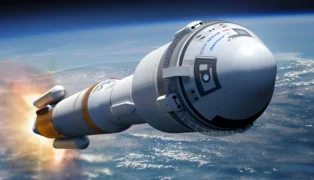The Boeing Starliner, a space capsule that astronauts designed for astronauts, is about to come back from space by itself. It took off for the International Space Station (ISS) on June 5 with NASA astronaut Sunita Williams, who has Indian roots, and Barry "Butch" Wilmore. This trip was the first time the spacecraft had a crew on board for a test. But because of some technical problems, the Starliner will fly back to Earth empty. This decision has made people raise questions and criticize Boeing's ongoing work in space.

A Return Without Crew: What Happened?
The Starliner is set to undock on September 6 and will fly back on its own touching down about six hours after it leaves the ISS. This unexpected solo trip is a big shift from the original plan. At first, Williams and Wilmore were supposed to test the spacecraft for eight days. The two astronauts, who've been on the ISS since June 6, were meant to come back in the Starliner. But now, because of ongoing engine problems with the spacecraft, they'll stay put until February 2025.
NASA shared its updated plan on August 24 explaining that bringing the astronauts back now would create unneeded risks. NASA leaders, after what sources called a "tense" talk with Boeing, all agreed to send the spacecraft back empty. This choice lets Boeing and NASA keep testing the Starliner as it heads home collecting key info to make sure the spacecraft is safe for future trips with people on board.

The Safety Call: Balancing Risks
Explaining the decision, NASA chief Senator Bill Nelson, who also flew in space, pointed out the dangers that come with space travel during test flights. "Space travel is dangerous even when it's at its safest and most regular. A test flight isn't safe or regular by its very nature," Nelson said. He stressed NASA's focus on safety, which pushed them to decide to keep Williams and Wilmore on the ISS and send the Starliner back by itself. "Safety is our main concern and guiding principle," Nelson added.
Boeing backed NASA's careful approach, despite having faith in the Starliner's abilities. The company stated it believed the spacecraft could return with or without people on board. Boeing pointed out that tests showed 27 out of 28 reaction control system (RCS) thrusters worked , and the propulsion system kept its backup options. But NASA still shaken by past tragedies like the Challenger and Columbia crashes, felt that even the tiniest doubt was too risky.

Challenges and Delays: The Starliner’s Rocky Road
Boeing's Starliner project has faced many delays and problems. Though promoted as the newest crew capsule, the spacecraft has had trouble meeting NASA's safety and performance standards for human space travel. Boeing got a $4.2 billion deal in 2014 to build the Starliner from the ground up. The plan was to create a reliable vehicle for taking people to low-Earth orbit. But it took almost ten years before the Starliner finally carried humans to space in June 2023.
In contrast, SpaceX got a similar deal for the Crew Dragon at a lower price of $2.6 billion and has been taking astronauts to space since 2020. enough, Sunita Williams and Barry Wilmore will come back to Earth in a SpaceX Crew Dragon, which shows how these two space companies have done.

Future of the Starliner: Boeing’s Commitment to Improvement
Even with the challenges, Boeing stays dedicated to Starliner's progress. NASA has restated its trust in the project but made it obvious that Boeing will cover the extra expenses to get the spacecraft certified for human space travel. The deal given to Boeing is a set-price contract, which means any more delays or added testing costs will be paid by Boeing.
The Starliner has run into many technical problems, including issues with its propulsion system and strange noises—which people later figured out were coming from a speaker. Even so, the spacecraft, which Williams called "Calypso" after the famous ocean explorer Jacques-Yves Cousteau's ship, stands for Boeing's wish to stay a big name in space travel despite these challenges.

Comments